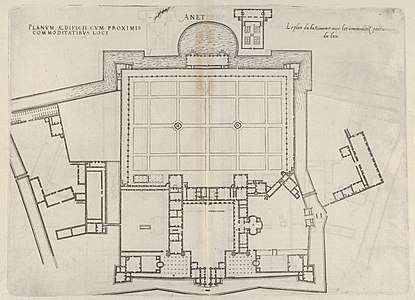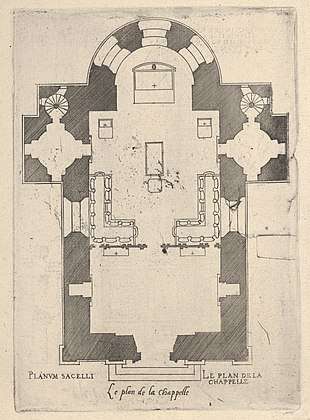Château d'Anet
The Château d'Anet is a château near Dreux, in the Eure-et-Loir department in northern France, built by Philibert de l'Orme from 1547 to 1552[1] for Diane de Poitiers, the mistress of Henry II of France. It was a gift from the king and was built on the former château at the center of the domains of Diane's deceased husband, Louis de Brézé, seigneur d'Anet, Marshal of Normandy and Master of the Hunt.
.jpg)
The château is especially noted for its exterior, notably the Fountain of Diana, a statue of Diane de Poitiers as Diana, goddess of the hunt,[2] and the Nymph of Anet, a relief by Benvenuto Cellini over the portal.[3] Anet was the site of one of the first Italianate parterre gardens centered on the building's facade in France; the garden-designer in charge was Jacques Mollet, who trained his son at Anet, Claude Mollet, destined to become royal gardener to three French kings.
History
The château, which faced south, was built partly upon the foundations and cellar vaults of a feudal castle that had been dismantled by Charles V and was subsequently rebuilt as a Late Gothic manor of brick and stone.
.jpg) Bird's-eye view, published by François L’Anglois in the early 17th century
Bird's-eye view, published by François L’Anglois in the early 17th century Design for the entrance portal, published in Philibert de L'Orme's Le Premier Tome de l'Architecture (1567)
Design for the entrance portal, published in Philibert de L'Orme's Le Premier Tome de l'Architecture (1567) Site plan, engraved by Jacques Androuet du Cerceau for his second volume of Les Plus Excellents Bastiments de France (1579)
Site plan, engraved by Jacques Androuet du Cerceau for his second volume of Les Plus Excellents Bastiments de France (1579) Frontispiece for the corps-de-logis, now at the École des Beaux-Arts in Paris
Frontispiece for the corps-de-logis, now at the École des Beaux-Arts in Paris
The château was not pillaged during the French Revolution, but Diane de Poitiers' remains were removed to a pauper's ditch in the parish cemetery and the rich contents of the château, which were the property of King Louis XVI's cousin, Louis Jean Marie de Bourbon, duc de Penthièvre, were sold at auction as biens nationaux. A large part of the château was subsequently demolished, but only after Alexandre Lenoir was able to salvage some architectural elements for his Musée des Monuments Français (presently situated in the École des Beaux-Arts in Paris). The elements were reinstalled at Anet after World War II.
.jpg) Replica of the Fountain of Diana at Anet
Replica of the Fountain of Diana at Anet.jpg) Fountain of Diana, engraved by Jacques Androuet du Cerceau (1579)
Fountain of Diana, engraved by Jacques Androuet du Cerceau (1579).jpg) Replica of Benvenuto Cellini's relief, the Nymph of Anet, located over the portal
Replica of Benvenuto Cellini's relief, the Nymph of Anet, located over the portal.jpg) Coat of arms
Coat of arms
The restoration of the château itself, in pitiable condition, was due to comte Adolphe de Caraman, who purchased it in 1840 and undertook a colossal program of restoration. In 1851, the minister of the interior granted Anet the status of a monument historique. Under financial duress, Caraman sold the château in 1860 to Ferdinand Moreau, who continued the restoration, purchasing furnishings and works of art that were thought to be originally from the château. The set of tapestry hangings woven for the château, in Paris, to cartoons by Jean Cousin, forming a History of Diana in compliment to Diane de Poitiers, is now widely scattered;[4] it set a precedent for suites of Diana-themed tapestries that remained popular into the 18th century.[5]
The now free-standing chapel of Anet was originally built in 1549-1552 as an appendage on the east side of the east wing of the cour d'honneur. It was designed on a centralized Greek cross floor plan under a diagonally-coffered dome. The original entrance was on the courtyard façade of the east wing, which was subsequently demolished. It has a porch with widely spaced paired Ionic columns between towers crowned by pyramidal spires. In 1581, Henri III and his mother Catherine de' Medici came to the chapel to attend the baptism of the infant son of Charles, duc d'Aumale.
- Photos of the chapel as it exists today
 Chapel entrance façade
Chapel entrance façade Side-view of the chapel
Side-view of the chapel.jpg) The chapel's spiral-coffered dome, designed by Philibert de L'Orme
The chapel's spiral-coffered dome, designed by Philibert de L'Orme
There is also the mortuary chapel, built according to Diane de Poitiers' last wishes to contain her tomb, commissioned from Claude de Foucques by Diane's daughter, the Duchesse d'Aumale.
- Designs for the mortuary chapel published by Jacques Androuet du Cerceau in 1579
 Chapel entrance façade
Chapel entrance façade Floor plan
Floor plan Transverse section[6]
Transverse section[6]
- Photos of the mortuary chapel ( 48.858326°N 1.437370°E )
.jpg) Entance façade
Entance façade.jpg) Interior view to the north
Interior view to the north.jpg) interior view to the south
interior view to the south
The property was owned, or at least occupied, by Louis Joseph, Duke of Vendôme. [7]
The property belonged to many of Louis XIV's descendants: Louise-Françoise de Bourbon died here in 1743, she was a daughter of the famous illegitimate son of Louis XIV, the Duc du Maine. His sons the prince des Dombes and comte d'Eu lived here when away from Versailles. It was later owned by the fabulously wealthy duc de Penthièvre, first cousin of the prince and the comte.
The castle was used as a filming location in the 1965 James Bond film Thunderball and 1976 film The Pink Panther Strikes Again.
The entry pavilion for Chateau d'Anet was the inspiration for the façade of Robert Venturi's 1966 Guild House for the Elderly in Philadelphia.
.jpg) Anet today
Anet today The portal
The portal- The park
Notes
- The date 1552 is inscribed on the gateway.
- Formerly attributed to Jean Goujon, the original is now in the Louvre. A copy is at Anet.
- The original is now in the Louvre, and a copy is at Anet.
- A Drowning of Britomartis at the Metropolitan Museum of Art was illustrated in the museum's Bulletin New Series, 12.6 (February 1954), p. 161; it is one of two from the suite at the Metropolitan Museum.
- Later examples to new cartoons are discussed by Roger-Armand Weigert, "Two tapestries in the Ashmolean Museum", The Burlington Magazine, 92 No. 568 (July 1950:193-195).
- Inscribed "Desseing du dedans de la Chapelle neufae hors le logis ou se doit mettre la sepulture feu madame la duchesse de Valantinois."
- Louis de Rouvroy, duc de Saint-Simon, Memoirs, ch xlv, Kindle edition.
References
External links
| Wikimedia Commons has media related to Château d'Anet. |
- Official Château d' Anet website
- Monographie du chateau d'Anet construit par Philibert de l'Orme en MDXLVIII, 1867, at the Kyoto University Library website